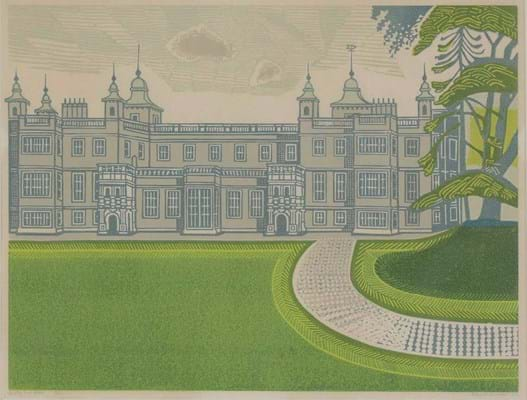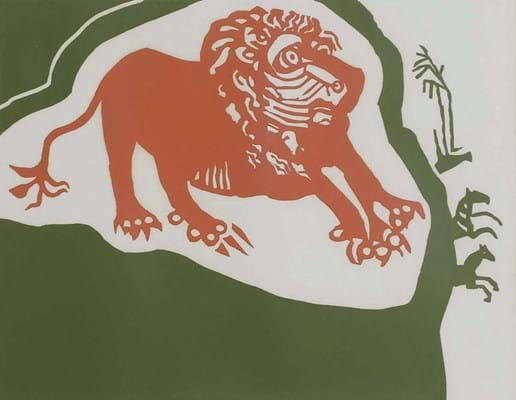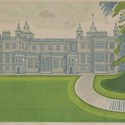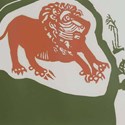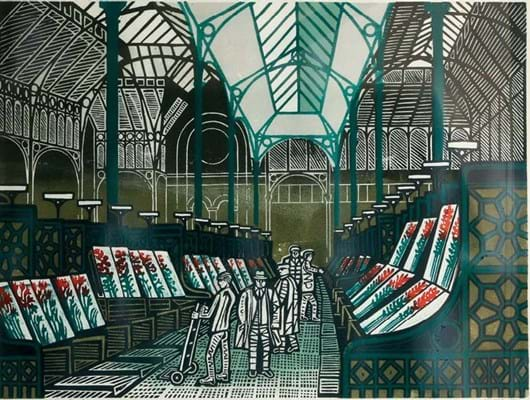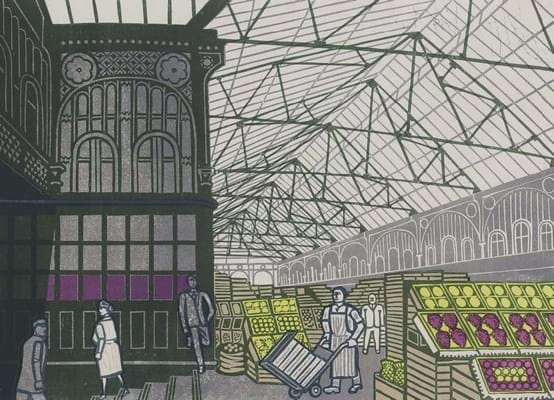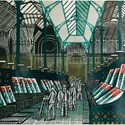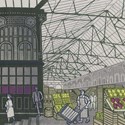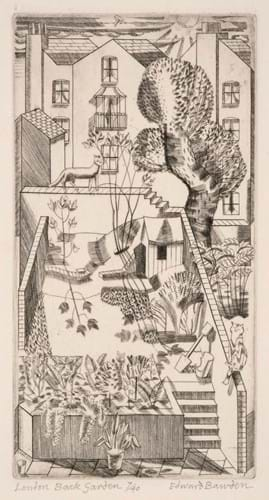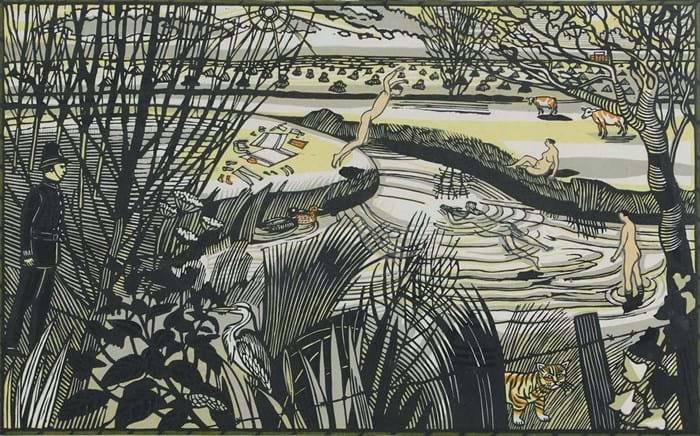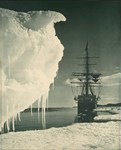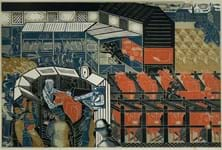Putting his considerable talent to use across a variety of media, Edward Bawden (1903-89) could be described an artistic polymath.
A painter, illustrator, watercolourist, mural and graphic artist as well as a teacher, his output stretched across an extraordinary visual spectrum. He even designed a cast-iron garden seat.
But the most celebrated part of his oeuvre are his prints.
Bawden’s artistic prints, which he produced alongside his more commercial work designing book covers and posters, have long been admired for their level of draughtsmanship, identifiable style, visual quality and wall power.
It was through careful experimentation that Bawden mastered the use of simplified lines and a rich colour palette.
He found the medium lent itself well to his rich visions of the English urban and rural landscape. The earthy tones and stylised forms he favoured created a Britain as it used to be: a hive of commercial activity or at peace with itself in the rolling countryside.
Bawden worked as a printmaker for over 60 years and produced over 200 editions in all, meaning there is plenty of scope for collectors.
His earlier works tended to be engravings and lithographs, but he later settled on the linocut which he deemed ‘very much a designers’ medium’.
Indeed, it was his series of linocut prints of London monuments and markets from the 1960s that cemented his reputation as a gifted graphic artist.
The prime period
Prints from the 1950s-70s, the highly-regarded middle decades of Bawden’s career, dominate the market. And, although made in multiples, they bring unusually high sums relative to the artist’s drawn or painted works.
It’s no accident that, while Bawden’s overall auction record is £30,000 for a large oil on panel, the highest for a print is a muscular £15,000 (see facing page).
The work of Christopher Richard Wynne Nevinson (1889-1946) and Sir Muirhead Bone (1876-1953), two fellow 20th century draughtsmen who arguably produced their best work in the printed medium, follows a similar model.
However, as is so often the case, the key market factors are subject, rarity, condition and colours, and it is these criteria that are the main determinants of value. Date is also important. Some impressions printed towards the end of his life are now found at the lower end of the Bawden prints market that begins at an affordable £200-300.
Among the most recent sales, Sworders of Stansted Mountfitchet offered 10 Bawden prints at its Modern and Contemporary Art auction on April 25, all of which sold.
Seven came from one local collector who, while still passionate about the artist, was simply clearing some space on their walls in order to purchase some different impressions.
An example bringing local demand was Audley End – a classic Bawden linocut and a favourite of the buyers for whom the English Heritage house is a familiar landmark.
From an edition of 150 signed impressions published in 1973, it measured 20in x 2ft 1in (50 x 63cm) and was in good overall condition despite some slight cockling.
Estimated at £800-1200, it took £1800, half the £3700 record for the edition set at Sworders back in 2014.
Further down the price scale, a copy of Lion and Zebras drew less demand. One of four linocuts commissioned by the National Art Collections Fund to mark Bawden’s retrospective exhibition at the V&A in 1989, it was among the last prints he made.
From an edition of 75, it measured 15 x 18in (39 x 47cm) and had a few condition issues including discolouration around the edges.
Estimated at £400-600, it sold at £380. The highest price for this edition was £550.
Edward Bawden: about the artist
Bawden was born in 1903 in Braintree, Essex. He studied at Cambridge School of Art and the Royal College of Art in London in the 1920s, training under the artist Paul Nash who noted that, along with his friend Eric Ravilious, he represented ‘an extraordinary outbreak of talent’.
He soon started working for the Curwen Press, making illustrations for organisations such as London Transport, Westminster Bank and Twinings, before later going freelance and producing promotional material for the likes of Fortnum & Mason and Imperial Airways.
During the Second World War Bawden was appointed an official war artist, travelling widely and spending two months in a Vichy internment camp following the torpedoing of RMS Laconia.
After the conflict, he returned to Great Bardfield in Essex where he had moved to in 1932 (initially sharing a house with Ravilious and his wife Tirzah Garwood). He remained in Great Bardfield until the 1970s when, following the death of his wife, he moved to Saffron Walden where he continued to work until his death in 1989.
His post-war career involved plenty of printmaking alongside his painting, illustration and commercial design work, including a commission for a 72-panel mural for the Festival of Britain in 1951. He also taught at the RCA, Goldsmiths, Royal Academy Schools and Leicester Polytechnic.
Brighton Pier
The auction record for an Edward Bawden print stands at £15,000 and is held jointly by three copies of Brighton Pier sold at Woolley & Wallis in December 2021, Forum Auctions in October 2022 and Christie’s back in 2009.
One of his largest linocuts, the image shows the pier framed by the familiar domes of the Brighton’s Royal Pavilion to one side and the architectural details of a Regency townhouse to the other.
Measuring 22in x 4ft 9in (55cm x 1.47m), the prints were too large for the studio press so the artist made them on the floor using his feet. He first printed them in an edition of 40 in 1958 while living in Brighton.
However, unusually for Bawden, he produced a second edition of the print nearly 20 years later. The 1977 linocut was made in an edition of 50 and varies from the first edition in subtle ways including in the general use of colouring, the pattern of the waves and the word Palace at the end of the pier which is black in the first edition but white in the second.
While the versions sold at Forum (pictured above) and Christie’s were from the first edition, the one sold at Woolley & Wallis was from the second – showing how the subject here remains the main attraction despite the difference in date.
Early engravings
At a time when the young Edward Bawden’s skills as a poster designer and book illustrator were much in demand in the mid to late 1920s, he was also busy experimenting with different forms of printmaking.
His mentor Paul Nash introduced him to the engravings of Jean-Émile Laboureur (1877-1943), the French artist who did much to revive interest in this traditional practice.
Bawden produced a series of 15 copper line engravings from 1927-29 which do not come to the market very often. They included subjects ranging from train stations to beach scenes but also included a few garden views, including one of Kew in London.
Another was London Back Garden which was produced in an edition of 40 signed copies.
An example emerged at Dominic Winter in Gloucestershire in October 2022. A clear impression which was in good condition and with provenance to London dealer Fine Art Society, it overshot a £500-700 estimate and sold at £950, seemingly the highest sum for the edition at auction.
Richard Bawden print
In keeping with his father’s trademark style, this print was created by Edward Bawden’s son Richard (b.1936).
A Splash in the Pant depicts his parents Edward and Charlotte Bawden together with fellow artists Eric Ravilious and Tirzah Garwood taking a dip in the river Pant near Great Bardfield on a hot summer’s day.
The scene is witnessed by the local bobby Sergeant Baker who lived in the police station next door to the artists and, it is said, was too embarrassed to apprehend them for their lack of bathing attire.
A second edition signed linocut from 2014, it was estimated at £600-800 and took an impressive £3800 at Sworders’ April 25 sale.


